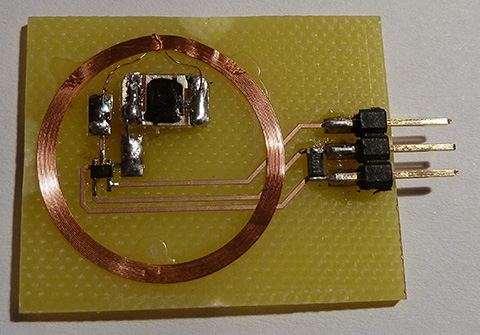
[Per] is replacing his car stereo with a Nexus 7 tablet. It’s a great modification to add GPS, navigation, and a good music player, but [Per] wanted to pause his tunes and tell the tablet to go to sleep with an NFC tag. This means building a an NFC tag he can turn on and off, an interesting problem to say the least.
The easiest way to do this is with a CMOS switch, but a chip like a 74HC4066 is overkill for a project this simple. What [Per] needed was a single CMOS switch, something he found and fabbed a board for.
Now, with a press of a button, [Per] can activate his NFC tag and pause the music in his new stereo. Check out the video of this electronically controllable tag after the break.
[youtube=http://www.youtube.com/watch?v=URi3WvEV8Z4&w=470]
















A little background would help, let’s start with Hey GUYS whats a NFC tag?
NFC: Near Field Communication.
An NFC “tag” is simply a device that actively or passively sends information to another NFC device. Exactly like the little things that people tap onto door locks to enter office buildings, etc.
“Active” means the tag is powered independently whereas “Passive” refers to a tag that requires power from the device it comes into contact with. A passive tag is therefore smaller than an active one – which is consumed spatially by a battery.
Youtube it :)
It’s what everyone is now calling RFID. You probably know what that is.
you’ll know about it when the option of carrying a card fades and you are requested to get chipped… #currentmastercardplan
[N]o [F]’ing [C]lue
…
until google
That’s an interesting way to go about it and somewhat elegant the more you think about it. Cool.
Hey. OP here. NFC is just a smart new name for the old Venerable MIFARE 13.56 MHz RFID tags. The NFC standard is an extra subset of functions, making it possible for NFC enabled devices to exchange data etc. Future Credit card terminals will use NFC, where you can pay with your NFC-enabled Cellphone.
Future? I’ve been doing it for a year now at McDonalds and using my Google Nexus HSPA+ I have seen these future credit card readers for well over 2 years now. Even home depot and Taco Bell has them.
In my opinion it is more “overkill” to source a special part than to just buy a SMT 4066 for a few cents.
I already had a bag of 50 laying around, so ehh…
I had some issues to put a comment to the author’s page. So here is my comment that should have gone there. Hopefully he sees it.
This is a very interesting approach. I wonder if this would have been possible without opening the tag at all. Right now I am researching Antennas for my DCF77 project http://blog.blinkenlight.net/2012/12/01/dcf77-project/ . Due to this research I think it should be possible to achieve a similar effect without opening the tag at all. The first idea would be to place a single loop between the tag and the NFC transceiver. Ideally the loop should be centered around the tag and parallel the tag’s antenna. Alternatively it could surround the transceiver in the same manner instead.
I’ve seen your comment, and it’s approved now. You had it posted 3 times. My theme fucks op completely, so i’ve resorted to another one now. Comments work correctly now!
eh, nfc’s still got some growing to do methinks, but i’m rather interested by the idea of replacing a stereo with a tablet 8D *goes to browse the site for examples of such*
Why not just interface through the USB port and make it a lot easier. What is it with people doing things the hard way? I need to change music tracks, I am going to mod this cellphone to send a Text message to a server at home that will change the message to a binary and then text it to my car stereo through a Infared morse code that the camera will pick up and interpet. A lot of hacks recently have been highly rube goldberg esque…
If he just interfaced through the usb port, he would have all the controls he wanted ready to go. plus control screen wake and sleep etc…
But you would have to plug it in every time and it would look ugly/out of place or something maybe?
“What is it with people doing things the hard way?” Because it’s more fun this way, that’s one of the points of hackaday, it is not?
The easy way would have been to pause/unpause by touching the tablet’s TOUCHscreen instead of touching the NFC pushbutton, but where would be the fun in that?
It would be great to use the NFC tag as a bridge between the car’s “CPU”, and the tablet. For example, if you have a steering wheel with buttons, that these buttons sends over the NFC a command to android… or if you have a little screen in the cockpit (like my car) you could use NFC to send data from tablet to the cockpit. Its only need some microcontroller and a CAN transceiver. But the problem with that is, how you send the audio from tablet to the car’s stereo? bluetooth?
Has nothing to do with NFC but i would like if you could charge you tablet wireless :D
I think the S3’s have inductive charging capabilities built in.
I’d have done it via bluetooth. You can send commands like play/pause, next, and back via AVRCP, and Android supports it very well.